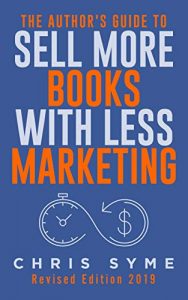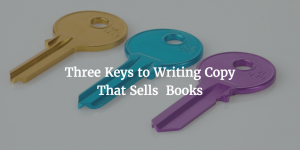 [Update 2020: This is a rare guest post from the wonderful Chris Syme—a woman who shares my combined interests in books and marketing. First published in 2017, the advice is timeless. There is an updated version of her book, which is linked in this article.]
[Update 2020: This is a rare guest post from the wonderful Chris Syme—a woman who shares my combined interests in books and marketing. First published in 2017, the advice is timeless. There is an updated version of her book, which is linked in this article.]
Book descriptions, blurbs, social media posts, ad copy. Even though you consider yourself an author, your head may start to spin at the thought of having to write a book description or copy for a Facebook ad.
Yes, copywriting is a different animal with a different goal than writing a book. But fortunately it’s a learned skill. To simplify the process of learning, let’s consider three keys to writing copy that will sell more books.
Put On Your Marketing Hat
First things first. Why is copywriting different than writing a novel or a nonfiction book?
Your goal is not to tell a story or teach, but to get the reader to take an action. If you approach copywriting with your marketing hat on it will make more sense. Before we look at the three keys, let’s define the marketer’s mindset.
1. Know that a well-crafted book description will sell more books. Your book description is not a throw away. Successful indie author Mark Dawson surveys his readers via email every year. In his recent survey he asked his readers what convinced them to buy one of his books. Of the 5000+ readers, the overwhelming majority said the book description. Don’t think good descriptions sell books? Think again. My reader surveys (much smaller sample than Mark’s) have confirmed the same. The book cover gets them to read the description and the description makes them click the buy button.
2. Think like a marketer. What influences people to buy a product? Authors need to use time tested marketing principles to help influence readers to buy.
- Social proof: Make sure your books get reviews and recommendations early. When people see a long line at a restaurant, they think the food must be good. That is social proof—lots of people like it; I will like it. Develop a strong advance review team. Use a “street team” to help you promote the book on social media. Build a network of loyal fans.
- Make them say yes. Marketers have used this technique for years and it’s critical in copywriting. Getting people to answer “yes” to a question makes it easier for them to say yes again when you ask them to buy. Make sure you touch on an emotion or experience that readers can identify with and say yes to.
- Authority. This one is particularly important for nonfiction writers. People respect recognized experts and want to follow their lead. Nonfiction writers should establish their expertise.
- Scarcity. The rule of the few. When there is a limited supply of something, people are anxious to act. Do you have a limited time preorder or launch sale? What about a bonus available for a limited time? Create an urgent need.
3. Remember the goal: get them to read the next line. Think of your copy as a compelling story. But story does not mean regurgitating the book’s plot. It’s about the story of the reader experience. Every line of copy needs to propel the reader to the next line. Remember people don’t buy stuff, they buy an experience. Where is your book going to take them? What problem will it solve? What emotions are you going to connect with? Marketers know how to push their buyers’ buttons.
The Three Keys
There are three keys every type of sales copy needs: a hook, compelling movement (or also called the “line”), and a call-to-action. Let’s break these down first as they apply to book descriptions. Then, we’ll take a look at how they may differ for ads and social media posts.
1. The Hook is Gold
Every copywriting expert I’ve ever learned from agrees that your hook is the most important piece of your copy. The hook is an attention-getting statement that will lay the foundation for the rest of your copy. In other words, it can’t be what we call “click bait”, or a sensational headline that grabs attention but has absolutely no relation to the book. Those hooks are cheating and usually make readers mad. Just don’t do it.
The hook is part of the traditional copywriting formula called “hook-line-sinker.”
A good hook is a promise. It will tease readers’ emotions and connect with a need the reader has. In fiction, it’s the need to read a good story or be entertained. In nonfiction, it’s the identification of a problem and promise of solutions your book delivers.
Hooks are not paragraphs; they are one or two sentences max. They may even be a sentence fragment. But one thing they do: make the reader want more information. Copywriter Bryan Cohen describes a hook this way: “If someone was making a movie of your novel, what would be the one liner on the poster?”
Many copywriting experts suggest that you brainstorm a list of hooks, leave them for a day, send them out to trusted friends, and revisit to distill. If you have an advance review team, they might be a good source of feedback. I suggest you not post your hooks in a general author Facebook group. Many of the authors there are not your readers, and different genres have different conventions. You’ll get good feedback from a small group of trusted people that know your genre and your voice.
Here are hooks I’ve run across that grab attention and connect with an emotion readers would be looking for in that genre. Let’s start with fiction; notice the different tone and voice in different genres:
- Could you murder your wife to save your daughter? (crime and thriller)
- What’s done in the dark will be brought to the light… (thriller and suspense)
- Three generations of women. One family funeral business. Two suitors. And a very fat cat. (cozy mystery)
- I was born into British aristocracy, but I’ve made my fortune in Manhattan. New York is now my kingdom (contemporary romance)
- Something frightening is happening to time. (Young Adult)
How about a couple from nonfiction that identify a problem-solution for readers in that genre?
- The difference between helping and selling is just two letters, but those two letters make all the difference. (marketing and sales)
- What if you could wake up tomorrow and every area of your life was beginning to transform? What would you change? (business and entrepreneurship)
All these hooks succeed in connecting with the genre’s audience and compel readers to move on to the next line.
NOTE: Sometimes a hook is placed after a declaration that has to do with the book’s bestseller status or its series—I’ve noticed this in the crime and cozy mystery genres quite a bit. If you begin your description with a declaration—a high profile recommendation, a nod to the book’s bestseller status or the name of the series—make sure that piece of the description is short and the bolded hook follows immediately.
2. Identify the Most Compelling Pieces
Whether your copy is a book description or a Facebook ad, take some time to identify the most compelling pieces of your book. The biggest mistake I see fiction authors make is just regurgitating a plot summary complete with at least four character full names and one or two towns thrown in where the action takes place. This is a mistake.
Sit down and brainstorm a list of the most compelling pieces of your book. What is driving the action? What is the conflict for the hero? Is there an important backstory you can tease? Nonfiction: what is the problem and what are the most important solutions?
Many fiction authors have a severe case of TMI (Too Much Information) when it comes to book descriptions. Here are some problem areas I see often:
- Too many character names — One or two will suffice and you don’t need last names.
- Too many locations— You don’t need to name every town involved in your book, or even one unless it’s a compelling part of your story.
- Spoilers – This isn’t just about giving away endings. Every backstory doesn’t need to be explained in the book description.
- Too many words to explain —Be succinct. Weed out the prepositional phrases and other poor writing. Write your book description and then edit, edit, edit. Bryan Cohen calls this cutting to the chase.
- Describing the hero’s entire journey —Leave something to the reader’s imagination that will make them want to read on.
- Wandering into secondary plots—Stick to the main events.
- Citing reader reviews in the description. Unless you have a well-known author or well-known publication’s endorsement, don’t put this in your description. Relegate all this info to the Editorial Reviews section.
- Don’t repeat yourself—This is especially true for nonfiction. Start with a list of benefits, prioritize them by which ones are the most life changing and limit yourself to five bullet points that address common pain points for all your readers.
The bottom line is that the description needs to tie pieces of compelling information together—not just the retelling of a story you believe is compelling. When it comes to sales copy, people will quit reading when you don’t keep them moving forward. Read your description out loud several times to make sure it sounds continuous and not choppy. The object in a good description: get readers to move to the next line. Personal note: I like to watch movie trailers in a genre when I am working on a description. Sixty seconds to entice people to see the movie. It’s good creative practice.
3. End With a Call to Action
The call-to-action is the “sinker” part of the hook-line-sinker formula. Many authors forget that a book description is, in fact, a sales description. You are trying to get the reader to buy something. You will be remiss if you don’t include a call-to-action at the end of your description. If they make it to the end, give them something to do to. Don’t be afraid to sound pushy–you won’t be. You got them this far, lead them to the logical conclusion.
Calls-to-action should not be just, “buy this book now.” There are a number of different ways you can ask people to buy. In Words That Sell, copywriter Richard Bayan has a wealth of suggestions. I highly recommend his book for anyone that writes any kind of sales copy. It sits on my desk.
Here are a few of my favorite examples for books:
- I invite you to…or You are invited…
- Get your copy now…
- Start reading today…
- Just click “add to cart”…
- Put this book in your shopping cart and start reading now…
- Can’t wait? Get your copy right now…
- Get it now for a limited time price…
- Join the story by grabbing your copy today
- Start (solution to problem) today…
What About Social Media Posts?
The formula for social media posts is pretty much the same except for the length. Twitter will give you only 140 characters and you should be thinking of no more than 400 or 500 on Facebook unless you are including buy links in your post.
There is a golden rule when it comes to selling on social media that many authors are missing: you must engage with people to earn the right to sell. The majority of your social media posts on any channel should be about adding value or making people feel an emotional connection. When you gain their trust and they see you as a valuable connection, you have earned the right to sell.
“Buy my book” billboard posts on social media without the element of an established relationship will never take full advantage of social media’s power to sell. If you abuse that purpose and just post sales ads, people will tune you out. Just don’t do it. Take the time to develop connections and trust. Then readers will give you permission to sell; and they’ll help you sell by telling their friends about you.
Good social media copy understands the psychology of buying and social media’s particular buying culture. People have different motivations for being on social media. People want to connect with other people and causes that fill an emotional need. According to research from HubSpot, people go to social media to feel:
- Happy. People love to laugh, smile, feel good about themselves, others, and their world.
- Inspired. Inspiration is a key to perseverance. Let’s face it—the world can be a cruel place. Inspiration gives us confidence and courage.
- Compassion. Compassion is the capacity to care about people and things outside ourselves. We all want to live in a caring world.
- Informed. It’s not just FOMO (Fear of Missing Out) that drives people to information. Help people stay on top of news, cultural trends, what’s going on with your books, and much more.
- Supported. People want to feel that they’re okay and that others identify with their lot in life. Be a friend to everyone and look for posts to share that celebrate diversity and hope.
- Connected. We humans have a driving need to connect with others. No man (or woman) wants to be an island.
 In my new book, The Author’s Guide To Sell More Books With Less Marketing I teach a social media copywriting formula called the 80-20 Content Rule. I explain that if 80 percent of your content is about adding value, readers will expect you to sell 20 percent of the time. You earn the right to sell by adding value first.
In my new book, The Author’s Guide To Sell More Books With Less Marketing I teach a social media copywriting formula called the 80-20 Content Rule. I explain that if 80 percent of your content is about adding value, readers will expect you to sell 20 percent of the time. You earn the right to sell by adding value first.
Ads
The copywriting formula for ads is much like the formula for book descriptions. You want to remember that the object of an ad is to sell something or sign someone up for something so it’s okay to reference buying in your hook or line sections.
In an ad, your hook is a promise. What are you delivering? An experience, a promise of rise in income, or a particular outcome after reading the book? Many good ad hooks start with a question about a universal problem that will lead to a “yes” answer from the reader, as I mentioned above. You also may hear the term “pain point,” especially as it relates to nonfiction books. What is your reader’s pain? How is your book going to solve that problem?
Good ad copy takes a lot of rewriting, editing, and rewriting again. The fewer character numbers you are allowed in the ad, the tougher the challenge. Amazon ads, for instance, are extremely short. The hook becomes the main attraction there. Facebook ads give you more rope to hang yourself. My college writing professor always said it is harder to write shorter. She was right.
No matter what kind of sales copy you write, it isn’t like writing a book. The three-key formula can guide you into writing effective succinct copy that will help you sell more books.
Chris Syme has over 20 years experience in the communications industry and is the principal of the award-winning agency, CKSyme Media Group. She is a former university media relations professional, a frequent speaker on the national stage, and the author of the popular SMART Marketing For Authors book series. Her book marketing books are available on Amazon, Kobo, and Nook. Her latest venture is Women Finishing Well.
